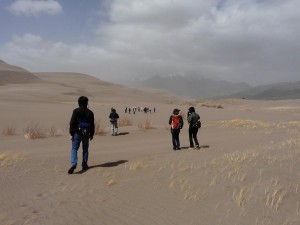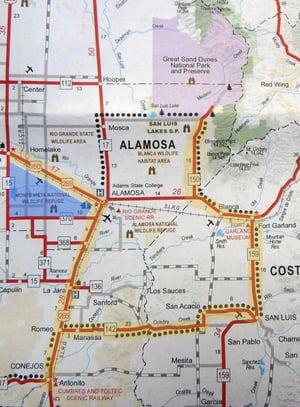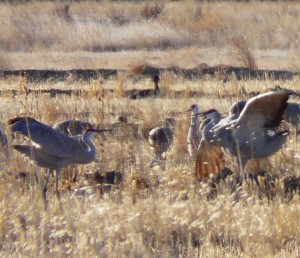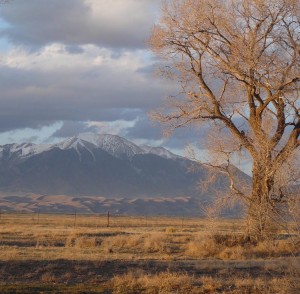Recently Walking Mountains led a group on a two day trip to witness this special event. Our home base was the Medano Zapata Ranch, located about 5 miles south of the Great Sand Dunes National Park entrance. The ranch is a conservation project owned by the Nature Conservancy encompassing about 120,000 acres south of the sand dunes. This land is home to a myriad of different wildlife species and contains the largest conservation herd of Bison in the country (approximately 2,000 head). With so much to see and do, we will endeavor to provide a montage of photos and content from the trip in the coming weeks. Your first glimpse is merely an overview of our itinerary. We hope you'll join us as we catalog our incredible journey following the Sandhill Cranes!
south of the Great Sand Dunes National Park entrance. The ranch is a conservation project owned by the Nature Conservancy encompassing about 120,000 acres south of the sand dunes. This land is home to a myriad of different wildlife species and contains the largest conservation herd of Bison in the country (approximately 2,000 head). With so much to see and do, we will endeavor to provide a montage of photos and content from the trip in the coming weeks. Your first glimpse is merely an overview of our itinerary. We hope you'll join us as we catalog our incredible journey following the Sandhill Cranes!
Day One:
After a fantastic Bison burger lunch, we began the trip with an introduction to the history and landscape of the Great Sand Dunes via a tour at the National Park. With Libbie Landreth as our very capable guide, we braved winds upwards of 35 mph to trek the dunes and learn a bit about the local ecology. It was a true adventure as the winds threatened to blow us away, sandblasting us into a permanent fixture of the landscape. Nevertheless, we persevered and even had a ton of fun along the way.
With a stunning backdrop provided by the Sangre de Cristo Mountain Range and Harard Peak, we learned about local flora and fauna, geology, and a few of the species who call the dunes home. Our Native American ancestors have even left some interesting informational footprints for us to explore in the park. We trekked out on the dunes to Medano Creek and back exploring and learning along the way. Our dunes trip ended at the park's Visitor Center where we took another educational foray into the region.
Our evening ended with some quiet time at the ranch and a tasty dinner of spicy Bison sausage and grilled chicken. Early to bed on this evening as cranes require early morning viewing.
Day Two:
Since the Sandhill Cranes bed down together at night and then disperse throughout the day to feed, we had to catch them just before sunrise. With an hour to drive this meant we were up and out the door by 5:30 am! Our destination was the Monte Vista Wildlife Preserve West of Alamosa. The cranes prefer wetlands and this protected area offers the best chance to find them. After a bit of searching, with Paul Robertson of the Nature Conservancy at the helm, we finally found them - thousands of majestic birds, feeding, dancing, and softly calling out to meet the day. The experience really was indescribable. If you've never been to this area, plan a springtime trip - the cranes alone are worth the visit.
It was chilly but we stayed and quietly viewed these awesome creatures for just over an hour. Next up was a historical and scenic tour of the Alamosa region. We began by visiting the oldest church in the state near La Jara, traveling on we stopped at a controversial "tin can" castle in Antonito, spied Mennonite buggies in Manassa, stopped for coffee in charming San Luis, discussed the history of Fort Garland, and ended the journey with a compressed air mirage feigning tall buildings on the grassland horizon. After a hearty Bison chili lunch we ventured out on the Medano Zapata Ranch to see some wildlife and discuss the history of the region. In one setting we were able to viewing Bison, coyote, sandhill cranes, deer, multiple species of waterfowl, larks, and even a snake. Not to mention the exceptional panorama provided by the dunes and the Sangre de Cristo Mountains. We took a short hike to the lake and witnessed many, many different species of colorful waterfowl. This journey ended with an exploration of the original ranch homestead which provided some great photo opportunities. After a long day, the evening ended with another fantastic dinner and some quiet time at the ranch.
 Day Three:
Day Three:
After a hearty breakfast and a quiet morning we all said our goodbyes and headed on home.
What a magical journey! We hope you'll enjoy a more in-depth overview with pictures and trip specifics as the coming weeks unfold.
This program was an adult invitational through Walking Mountains Science Center and the Nature Conservancy. If you are interested in future trip schedules and locations, please contact Walking Mountains at (970) 827.9725.











